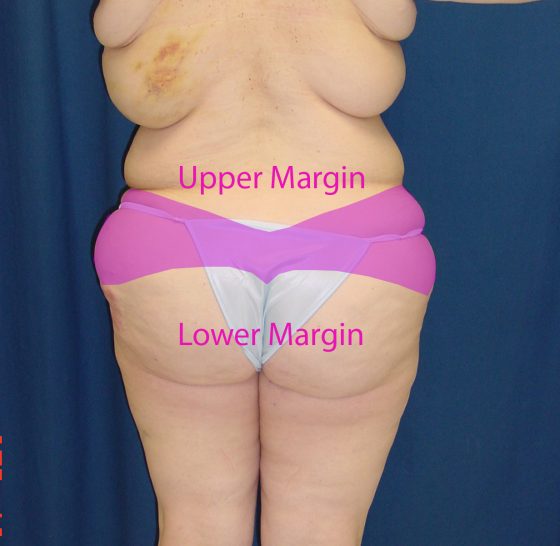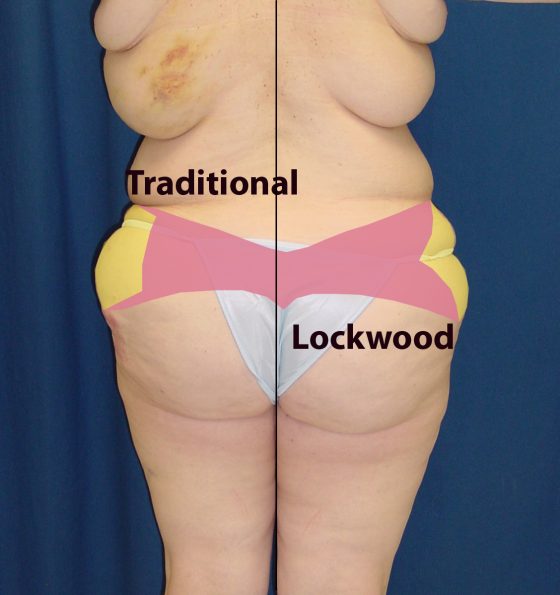A Lower body lift, or Belt lipectomy is the combination of a Tummy Tuck, Outer Thigh Lift, and Posterior Buttock Lift performed in the same operative session. The ideal candidate for Body lift has excessive amounts of skin. Many Body lift patients have experienced massive weight loss and therefore have lots of hanging skin. Getting the best results comes from taking out the right amounts of fat and skin. It is not proper to take out too much skin or too much fat. I believe that the Lockwood technique provides the best method for excising precisely the right amount of fat and skin.
Amount of skin and/or tissue removed

The image to the left shows the pre-operative markings that I make on my patients the morning of surgery. This back view shows the markings for the posterior buttock lift part of the surgery. I make these markings while the patient is standing in front of a mirror. I discuss everything with the patient as I make the markings. The pink shaded area represents the skin which will be removed.
Before I actually make the surgical markings, I first discuss the exact scar placement with my patient . With the patient in front on a mirror, I draw it on the patient’s skin. The upper margin is drawn first.
The upper margin of the excision represents the proposed level of the scar. The lower margin is determined by pulling the upper surgical marking down. During the surgery, the skin and fat between the two margins are removed. However, I am very careful to remove just the right amount of fat. If too much fat is removed in the subcutaneous layers it can lead to problems with the wound closure and fluid collections.

To prevent these types of problems, I use the Lockwood technique. The Lockwood technique results in a more robust and secure skin closure. The technique preserves more of the subcutaneous tissues which allows for a firmer wound closure. This prevents post op complications such as wound separation and fluid collections. In the picture below, I illustrate how the two Body lift techniques, Traditional vs. Lockwood, result in different amounts of fatty tissue excised.
Traditional Body lift technique
On the left side (Traditional) of the diagram, the yellow cutout pattern represents the amount of fat that would be removed with the conventional Body lift technique. There is more empty (yellow) space between the upper and lower margins of skin. With too much fat removed, this results in more tension being applied to the skin layers, which can create problems in the recovery. With more tension on the skin layer closure, the risk of wound separation in the post op period is higher.
Lockwood Body lift technique
On the right side of the diagram (Lockwood), using the Lockwood technique, there is less empty (yellow) space. Less empty space is better because the tissues come together with minimal tension, so they don’t come apart in the postoperative period. Likewise, there is less space for fluid accumulations, and the blood supply coming from the muscles below is better preserved. The body heals faster and better with less complications. This is what makes the Lockwood technique superior to the traditional body lifting technique!
In another post, I will do some line drawings to explain the technical details of how the empty space impairs healing. It has to do with blood supply, strength of tissues, and the fact that nature abhors a vacuum.



